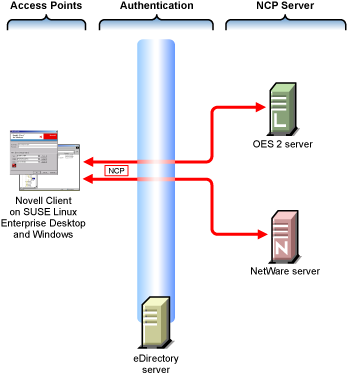5.5 Upgrading NetWare Core Protocol (NCP) File Services
The NetWare Core Protocol (NCP) Server provides the same file services on OES 2 that are available on NetWare.
5.5.1 About NCP File Services in OES 2
What NCP Server Provides
With NCP Server, you can define NCP volumes (NCP shares on Linux Ext3 and Reiser file systems). The advantage of using an NCP server is that you can control access using the Novell trustee model. Windows and Linux workstations running Novell Client software can access data and manage file sharing on OES 2 servers just as they do on NetWare servers, unless they need NSS file attributes (see What NCP Server Alone Doesn’t Provide).
Novell NCP Server for OES enables support for login scripts, mapping drives to OES 2 servers, and other services commonly associated with Novell Client access. This means that Windows users with the Novell Client installed can be seamlessly transitioned to file services on OES 2.
Services provided by NCP include file access, file locking, security, resource allocation tracking, event notification, and synchronization with other servers.
NCP is a client/server LAN protocol. Workstations create NCP requests and use TCP/IP to send them over the network. At the server, NCP requests are received, unpacked, and interpreted.
Figure 5-4 illustrates the basics of NCP file services.
Figure 5-4 NCP Services for OES and NetWare

The following table explains the information illustrated in Figure 5-4.
|
Access Methods |
Authentication |
NCP Services |
|---|---|---|
|
Access is through an NCP client—specifically, the Novell Client. |
All file service access is controlled by eDirectory authentication. |
Files are stored on NetWare or NCP volumes that the administrator has created. The same core set of NetWare file attributes are available on both OES and NetWare. |
What NCP Server Alone Doesn’t Provide
NSS file attributes and NCP services tend to get mixed together in the minds of NetWare administrators. It is important to remember that file and directory attributes are supported and enforced by the file system that underlies an NCP volume, not by the NCP server.
For example, even though the Rename Inhibit attribute appears to be settable in the NCP client interface, if the underlying file system is Linux POSIX (Reiser, etc.) there is no support for the attribute and it cannot be set.
Salvage (undelete) and Purge are other features that are available only on NSS and only where the Salvage attribute has been set (the NSS default). They can be managed in the NCP client and through NetStorage, but they are not available on NCP volumes where the underlying file system is Linux POSIX.
Some administrators assume they can provide NSS attribute support by copying or moving files, directories, and metadata from an NSS volume to a defined NCP volume on a Linux POSIX partition. However, this doesn’t work, because NSS file attributes are only supported on NSS volumes.
5.5.2 Planning to Upgrade NCP File Services
Requirements
Table 5-7 NCP Source and Target Server Requirements
|
Source Server |
Target Server |
|---|---|
|
NetWare 5.1 or later |
OES 2 SP3 |
|
The NCP Server pattern is installed. |
|
Data can be moved independently of the server. Users can always see what they have rights to see. |
Deciding Between a Linux POSIX File System and NSS
For most system administrators, the most critical point of this decision is whether your organization relies on NSS file and directory attributes as a key component of the Novell Trustee Access model. If the answer is yes, then you should move your data to NSS volumes on OES 2, or mount existing NSS volumes on the OES 2 servers.
If your organization doesn’t rely on NSS file and directory attributes and wants to transition to NCP volumes defined on Linux POSIX file systems, then you can create those volumes on the target servers and move the data by using the OES 2 SP3 Migration Tool.
The Novell Client Is Required
Novell Client software is required to initiate an NCP connection between a Windows or Linux workstation running Novell Client software and an OES server running NCP Server services. Intelligence at both ends of the connection works together to verify that clients are who they claim to be, and that access controls are followed when using shared server files.
5.5.3 Only Data Transfers Are Required
You provide NCP services on an OES 2 server by installing the NCP Server pattern. There is no upgrade path for the NCP server running on NetWare to NCP Server on OES.
If the data is properly moved to ensure that trustee assignments are left intact, users can access their data using a Novell Client on a Linux or Windows workstation just as they did when the data resided on a NetWare server.